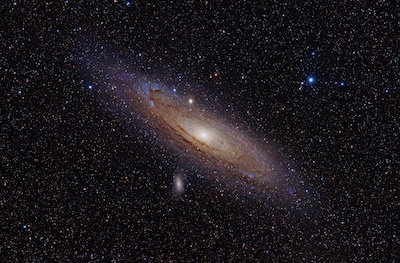



|

|

Gravity theory suggests M31 and Milky Way have history
BY KEITH COOPER
ASTRONOMY NOW
Posted: 5 July 2013

Our Milky Way and the Andromeda Galaxy may have experienced a coming together ten billion years ago, leaving behind evidence that can only be explained by an alternative theory of gravity, says a team of scientists including Dr Hongsheng Zhao of the University of St. Andrews.

The Andromeda Galaxy, M31. Image: Adam Evans.
The research, presented by Zhao at the Royal Astronomical Society's National Astronomy Meeting this week, seeks to find an explanation for the recent realisation that dwarf galaxies and streams of gas and stars form a 'vast polar structure' in the shape of a disc that is perpendicular to the Milky Way, encircling it. The Andromeda Galaxy also has a similar structure. Neither structure is particularly unusual - we see similar 'polar rings' around galaxies that have experienced collisions and close encounters with other galaxies, where the gravitational tidal forces have drawn out gas from the sideswiping galaxies. This gas forms a tail that eventually coalesces to create small satellite galaxies known as tidal dwarfs.
The only problem with this scenario is that, according to the standard picture of galaxies with haloes of dark matter, the Milky Way and Andromeda are yet to experience a close encounter. In fact, we are scheduled to collide with the Andromeda Galaxy in three billion years, or thereabouts. So where have the polar rings come from?
Dark matter is still a controversial topic. We observe what we infer to be its gravitational effects, such as the rotation of stars in galaxies, or the distribution of mass in colliding galaxy clusters, but we cannot see dark matter itself, nor examine it. There has been tentative evidence by the Alpha Magnetic Spectrometer onboard the International Space Station of the detection of gamma-rays or charged particles produced by dark matter particles annihilating near the centre of the Galaxy, but some scientists are still sceptical. Since 1983 an alternative, or enhanced, theory of gravity proposed by Mordehai Milgrom of the Weizmann Institute in Israel has been gradually making inroads. Called MOND (Modified Newtonian Dynamics) it describes how gravity operates differently for small gravitational accelerations on large scales, removing or at least lessening the need for dark matter in the Universe.
By applying MOND to the motions of the galaxies in the Local Group (consisting of the Milky Way, Andromeda, M33 and a smattering of dwarf galaxies) and not adding dark matter, Zhao's team made a surprising discovery: if MOND is real, then the Milky Way and Andromeda have collided before, a glancing blow ten billion years ago. This would explain the polar ring structures that we see around both galaxies today.

MOND'S prediction of the motion of the Andromeda Galaxy and the Milky Way. Ten billion years ago they had a close encounter, and now M31 is beginning to loop back around. Image: Fabian Lueghausen/University of Bonn.
"In the standard framework they cannot have such a close encounter," says Dr Benoit Famaey of Observatoire Astronomique de Starsbourg, who was part of the research team. "It is an important point because if the need for a past encounter to explain the discs of satellites in the Milky Way and Andromeda is confirmed, it is not possible to invoke a dark matter halo reproducing the exact same force because the dynamical friction with dark matter particles would trigger a merger."
Clearly the Milky Way has not yet merged with Andromeda, so MOND perfectly explains the presence of the polar ring structures in a way that dark matter cannot. "In the standard dark matter picture we have not been able to gain a consistent understanding of what we see in the Local Group of galaxies, but in MOND everything makes much more sense," adds Professor Pavel Kroupa, a team member from the University of Bonn. "Tidal dwarf galaxies are of too low mass to capture much dark matter, so since they however do show the effect of dark matter - it seems the stars and gas in them is moving too rapidly - one must invoke a stronger gravity, and this is exactly what MOND gives us."
If correct then MOND has possibly unearthed a part of the Milky Way's hidden history - a titanic close encounter that will be repeated in around three billion years time as Andromeda and the Milky Way race towards one another. Although the battle between dark matter and MOND will continue for some time, both are certain that another collision is inevitable. How it plays out, however, might be different depending on which theory you subscribe to. Dark matter predicts a direct collision and merger, or at least a series of rapid flybys before the two galaxies ultimately coalesce. MOND, on the other hand, predicts another grazing blow, messing the galaxies up a bit and creating more tidal dwarfs from gas torn out of each galaxy. "The Milky Way and Andromeda will, however, separate again and they will continue this dance for some time," says Kroupa.
Adds Zhao, "Galaxies are much thinner and leaner in MOND as they only have a small disc and are not burdened with a fat halo that stops galaxies moving past each other."
Ultimately, however, both models predict that they will merge, but if you believe MOND, then it might just take then a little while longer.
|

|

|

|
|



